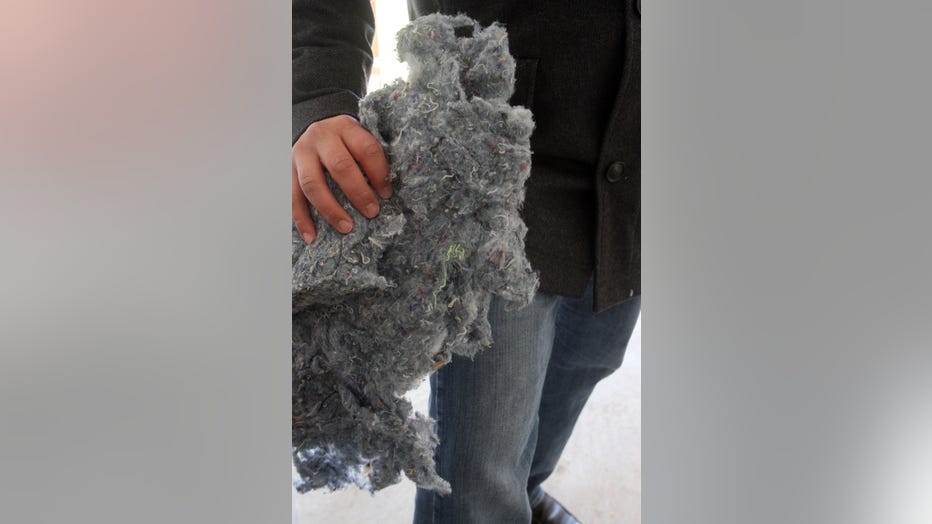How textile recycling is giving a ripped shirt new life
Clothes and blankets, it turns out, can keep you warm in more than one life. That beloved sweatshirt that kept you warm through college but now has holes and stains is not necessarily destined for the dumpster anymore. It can still keep you warm and cozy in its second life as a piece of insulation.

Home insulation made from recycled textiles.(Photo By Liz Hafalia/The San Francisco Chronicle via Getty Images)
"My house has it…textile insulation," said Serge Lazarev, Founder of Green Tree Textiles. "Fiberglass [insulation] is really bad. It's horrible to touch or inhale and textile insulation is really soft and like pleasant -- you could put your face down and sleep on it."
Larazev's company takes the 80 pounds of unwanted clothes the EPA says American’s shed each year and re-donates what he can to various charities and for profit or organizations, about 40% of what comes in, and recycles the rest. He partnered with a company that turns threadbare towels, stained shirts and torn jeans into home insulation.

Rolls of recycled fabric insulation ready for a home's ceilings and walls.(Photo by James Keyser/Getty Images)
"Recently I saw this insulation Home Depot, textile insulation, said Lazarev of the textile insulation becoming more mainstream. "It was a package that was ready to just be put into a blower and blown into the walls and the ceilings that needed to be insulated. So that was exciting."
"About 10 years ago, I was a polluter. I was operating gasoline, retail stations, mechanic shops, stuff like that," said Lazarev. "[The President] was talking about how the government was going to invest into green jobs and green fields, and it really resonated with me. I was like, ‘You know, it's time we started taking care of our planet because this can't go on forever like this.’"
He looked into new business opportunities. Getting into solar power was prohibitively expensive Lazarev said. Recycling bottles and cans was already a saturated market.

Americans get rid of over 80 pounds of clothing and textiles per year, according to the EPA.(Photo by Alain BUU/Gamma-Rapho via Getty Images)
"And then I stumbled on an interesting statistic that said that 85% of the textiles were not being picked up for recycling, and it was going to the landfills and the light bulb went off," he recalled. "So I made that 180-degree turn around into recycling."
7 THINGS TO KNOW ABOUT THE HISTORY OF EARTH DAY
The EPA reported that in 2018, Americans generated over 17,000 tons of textile waste. Over 11,000 tons ended up in landfills which is 7.7% of landfill waste. They estimated that only 13% of textiles are recycled.

The bulk of unwanted textiles ends up in landfills. The amount has steadily risen since 1960. (Environmental Protection Agency)
He looked into selling the textiles in his warehouse for rags, bedding and mattress and pillow stuffing but found that selling for insulation is more economical.
"It's very convenient to recycle into textile insulation because it doesn't require any more separating process," said Lazarev. "It could be cotton, wool/cotton blend. It could be Velcro or jersey, or just a lot of different materials. Rather than separating something like 100 percent cotton, 100 percent wool, It's very labor-intensive, and we don't have machinery, All the manpower or the labor costs like becomes unaffordable, really."

Green Tree has about 100 manned and un-manned donation bins across the New York Metro area. (Green Tree Textiles)
Green Tree Textiles recently partnered with a shoe recycler.
"This is one of the challenges that we face in the recycling industry is all the materials that a garment or a shoe is composed of… the little rings that hold the shoelaces, and they made out of metal, then there's plastic in there and leather," said Lazarev. "Their recycling process usually takes place overseas. One company does it here… but you can only go for a specific type of shoe. It's complicated."
Green Tree has about 100 bins at farmers’ markets, community centers and apartment buildings in a 100-mile radius around the Bronx, New York headquarters. The company partnered with Down to Earth Markets to make it easier for communities to donate.

Plastic, paper and glass recycling bins are around every corner. Lazarev wants to see textile bins with them. (Lindsey Nicholson Education Images/Universal Images Group via Getty Images / Getty Images)
"The whole thing with textile recycling is it's got to be convenient, just as convenient as recycling your bottles and cans. Those containers are everywhere," said Lazarev. "And so we try to bring it to the community. Whether it's a community organization, community center… Down to Earth Markets provides a platform. Anybody who wants to host or have bins with us, we're open to having that conversation. Our service is free, our bins are free."
Anyone can bring their tax-deductible donation of clothes, purses, hats, shoes, bedding even curtains to one of their sites/bins. The 10 employees collect the textiles and sort the re-usable goods from the recyclable ones. Anything that is beyond its useful condition or not clean in its current life heads for the next life, insulation.

Each truck drops about 20 tons of trash in a landfill.(Michael Macor/The San Francisco Chronicle via Getty Images / Getty Images)
Green Tree Textiles keeps an estimated 2.1 million pounds of textile waste out of landfills and incinerators per year in the New York area.
"There's room to grow here," said Lazarev doing calculations. "So just in New York City, there's eight million people..,and 640 million textiles [trash] annually."
LINK: Get updates and more on this story at foxweather.com.


